#l: göttingen
Photo


Danke. Ich meld mich, wenn ich Hilfe brauch.
Florence Kasumba as Anaïs Schmitz in Tatort: Die Rache an der Welt (2022)
#tatortedit#tatort#tatort göttingen#nalle#isalabells#moonstark#*edit#c: anaïs schmitz#a: florence kasumba#f: die rache an der welt#l: göttingen#was this episode good? no. was she good? yes.
62 notes
·
View notes
Text
14.04.1935
It is a bit ironic that one of the first posts to be published on this blog is about Emmy's death, which was today 89 years ago (and similarly the last post will be on her birthday). This will probably also be the longest post since in addition to general information about her death I will also add parts of memorial speeches and letters from her colleagues. But let us start with details about her death first.
After the initial recovery from Emmy's uterine surgery on April 10 went rather well for the first few days, on April 14 her condition suddenly worsened. One of the doctors, Dr. James L. Lichards, described it to Marion Edwards Park (the president of Bryn Mawr College) in a letter from April 24 as follows:
At operation the pelvic tumor was found to be a large ovarian cyst the size of a large cantaloupe. [...] During the early morning of her fourth post-operative day she developed a circulatory collapse from which she seemed to rally under treatment. At noon on that day she suddenly lapsed from consciousness to complete coma with loss of reflexes and a rise of temperature from 102 degrees to 108 degrees. Dr. David Riesman, who saw her in consultation, was of the opinion that, as a part of Dr. Noether’s general circulatory collapse, a blood vessel had ruptured in the region of the vital centers in her head which had caused her sudden relapse at a time when she seemed to be rallying. From that point, Dr. Noether rapidly failed in spite of every effort to save her.
According to Dr. Brooke M. Anspach, another one of Emmy's doctors, it was in fact very likely that Emmy would have died in the near future, if not from complications with this surgery. In her letter to Marion Park from April 15 she states it as follows:
If it is any comfort I may tell you that we have every reason to believe that the outcome was impossible to avoid. Dr. Noether evidently had some unrecognizable disability which would have made itself suddenly manifest without any more exciting cause than her usual routine of work. Unfortunately we see every once in awhile one of our friends apparently in good health suddenly stricken; it would have been the same with her some time. Without doubt the operative procedure hastened it but of course the operation was necessary and if the tumor had not been removed it alone would have been sufficient to have cause her death.
Emmy's death came as a shock to everyone, especially since Bryn Mawr, the Rockefeller Foundation, and Princeton were in deep talks to transform Emmy's temporary appointment at Bryn Mawr into a permanent position. Marion Park held a smaller funeral service at her home with some of Emmy's friends and colleagues on April 17 and there was a larger memorial service in Goodhart Hall, Bryn Mawr College, on April 26, 1935.
There are two memorial accounts I would like to highlight here, the first of which is from a letter by Albert Einstein to the New York Times, which was printed in the Times on May 3, 1935:
In the judgment of the most competent living mathematicians, Fräulein Noether was the most significant creative mathematical genius thus far produced since the higher education of women began. [...] Her unselfish, significant work over a period of many years was rewarded by new rulers of Germany with a dismissal, which cost her the means of maintaining her simple life and the opportunity to carry on her mathematical studies.
The second one is from an obituary printed in the Bryn Mawr Alumnae Bulletin from May 1935:
Professor Brauer, in speaking recently of Miss Noether’s powerful influence professionally and personally among the young scholars who surrounded her in Göttingen, said that they were called the Noether family, and that when she had to leave Göttingen, she dreamed of building again somewhere what was destroyed then. We realize now with pride and thankfulness that we saw the beginning of a new ‘Noether family’ here. To Miss Noether her work was as inevitable and natural as breathing. A background for living taken for granted; but that work was only the core of her relation to students. She lived with them and for them in a perfectly unselfconscious way. She looked on the world with direct friendliness and unfeigned interest, and she wanted them to do the same. Mathematical meetings at the University of Pennsylvania, at Princeton, at New York, began to watch for the little group, slowly growing, which always brought something of the freshness and buoyance of its leader.
After Emmy's body was cremated, her ashes were placed under the walkway around the cloisters of M. Carey Thomas Library at Bryn Mawr College.
6 notes
·
View notes
Text

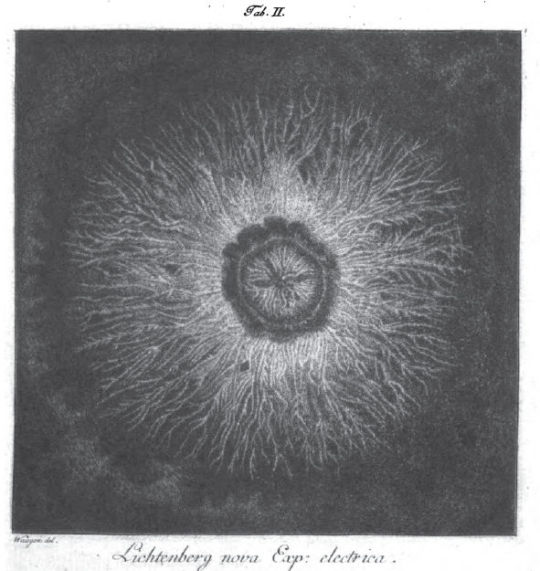
What are Lichtenberg figures?
"Lichtenberg figures" are branching, tree-like patterns that are created by the passage of high voltage electrical discharges along the surface, or inside, electrically insulating materials(dielectrics).
The first Lichtenberg figures were actually 2-dimensional "dust figures" that formed when airborne dust settled on the surface of electrically-charged plates of resin in the laboratory of their discoverer, German physicist Georg Christoph Lichtenberg (1742-1799).
Professor Lichtenberg first observed this in 1777, demonstrated the phenomenon to his physics students and peers, and reported his findings in his memoir (in Latin): De Nova Methodo Naturam Ac Motum Fluidi Electrici Investigandi (Göttinger Novi Commentarii, Göttingen, 1777). The English translation of the title is, "Concerning the New Method Of Investigating the Nature and Movement of Electric Fluid". Lichtenberg's translated paper is contained in Appendix A of a Masters thesis by Mark A Payrebrune ("Experimental Morphology of Lichtenberg Figures", McGill University, Montreal, Canada, 1979). The translated document (by Dr. J. Blain, Classics Department at McGill University) contains the following passage that describes Lichtenberg's initial discovery:
"At the beginning of spring 1777, after the completion of the new Electrophore, everything in my little room was still covered with extremely fine resinous dust that had settled, between the scraping and the shaving of the instrument's base or stand, on the walls and books. As soon as a draft in the air arose, the dust fell, much to my annoyance, on the conducting disc of the Electrophore. Often afterwards, when I held the disc suspended from the ceiling of my room, it turned out that the dust, as it settled on the base, did not cover it completely, as it previously had covered the disc, but only in certain areas. Much to my great joy, it gathered to form little stars, dim and pale at first, but as the dust was more abundantly and energetically scattered, there were very beautiful and definite figures, not unlike an engraved design. Sometimes there appeared almost innumerable stars, milky ways, and great suns. There were arcs, unclear on their concave side, but radiant on their convex side. Very glittering little twigs were formed, similar to those which frozen moisture produces on glass window panes. There were clouds of different shape and shadows that were visible in varying degrees ... But the most pleasing sight presented itself to me, when I saw that these figures could not be easily erased, as I tried to wipe away the dust with a feather or a rabbit foot. I could not prevent these same figures, which I had just erased, from shining forth once more, and somehow, more brightly. Therefore l placed a piece of black paper smeared with a viscous material on the figures and pressed down lightly. I was able to produce imprints of the figures, six of which the Royal Society has seen. [Note: see figures below]. This new kind of Typography has been extremely satisfying to me, hastening as I was to more remote preoccupations and having neither the time nor the inclination of sketching the figures or destroying them all."
Read>
2 notes
·
View notes
Text
Film Review - Oppenheimer
Now we come to what I feel has been the cinematic centrepiece of 2023 films, and after so long on science-fiction franchises, it’s a real breath of fresh air in the realm of war-era biographical drama from what I’ve recently been looking through. Yes, folks, this is my review of Christopher Nolan’s Oppenheimer…
Plot (as adapted from Wikipedia):
In 1926, the 22-year-old doctoral student J. Robert Oppenheimer grapples with anxiety and homesickness while studying experimental quantum physics under Patrick Blackett at the University of Cambridge. Oppenheimer clashes with Blackett and leaves him a poisoned apple but later retrieves it. Visiting scientist Niels Bohr advises Oppenheimer to study theoretical physics at the University of Göttingen.
Oppenheimer completes his PhD and meets scientist Isidor Isaac Rabi. They later meet theoretical physicist Werner Heisenberg in Switzerland. Wanting to expand quantum physics research in the US, Oppenheimer teaches at the University of California, Berkeley and the California Institute of Technology. He marries Katherine "Kitty" Puening, a biologist and ex-communist, and has an intermittent affair with Jean Tatlock, a troubled communist psychiatrist who later dies by suicide.
When nuclear fission is discovered in 1938 after the Germans succeed in splitting the atom, Oppenheimer realizes it could be weaponized. In 1942, during World War II, US Army Colonel Leslie Groves, the director of the Manhattan Project, recruits Oppenheimer as the director of the Los Alamos Laboratory to develop an atomic bomb. Oppenheimer fears the German nuclear research program, led by Heisenberg, might yield a fission bomb for the Nazis.
Oppenheimer assembles a team consisting of Rabi, Hans Bethe, and Edward Teller, and collaborates with the scientists Enrico Fermi, Leo Szilard, and David L. Hill at the University of Chicago. Teller's calculations reveal an atomic detonation could destroy the world. After consulting with Albert Einstein, Oppenheimer concludes the chances are acceptably low. Teller attempts to leave the project after his proposal to construct a hydrogen bomb is rejected, but Oppenheimer convinces him to stay.
After Germany's surrender in 1945, some scientists question the bomb's relevance. Oppenheimer believes it would end the ongoing Pacific War and save Allied lives. The Trinity test is successful, and President Harry S. Truman orders the atomic bombings of Hiroshima and Nagasaki, resulting in Japan's surrender. Though publicly praised, Oppenheimer is guilt-ridden and haunted by the destruction and mass fatalities. After Oppenheimer expresses his guilt to Truman, the president berates him and dismisses his plea to cease further atomic development.
As an advisor to the United States Atomic Energy Commission (AEC), Oppenheimer's stance generates controversy, while Teller's hydrogen bomb receives renewed interest amidst the burgeoning Cold War. AEC Chairman Lewis Strauss resents Oppenheimer for publicly dismissing Strauss's concerns about exporting radioisotopes and for recommending negotiations with the Soviet Union after the Soviets successfully detonated their own bomb. Strauss also believes that Oppenheimer denigrated him during a conversation Oppenheimer had with Einstein in 1947.
In 1954, wanting to eliminate Oppenheimer's political influence, Strauss secretly orchestrates a private security hearing before a Personnel Security Board concerning Oppenheimer's Q clearance during which his loyalty to the United States is questioned. However, the hearing is a trial in all but name. Oppenheimer's past communist ties are exploited and his associates' testimony is twisted against him, with Teller's being the most damaging. After Kitty delivers impassioned testimony in defence of herself and her husband, the board no longer suspects Oppenheimer of disloyalty but revokes his clearance, thereby damaging his public image and limiting his influence on American nuclear policy.
In 1959, during Strauss's Senate confirmation hearing for Secretary of Commerce, Hill testifies about Strauss's personal motives for engineering Oppenheimer's downfall. Strauss's nomination is voted down. In 1963, President Lyndon B. Johnson presents Oppenheimer with the Enrico Fermi Award as a gesture of political rehabilitation.
A flashback reveals that Oppenheimer and Einstein's 1947 conversation never mentioned Strauss. Instead, the two discussed Oppenheimer’s legacy, and Oppenheimer expressed his fear that they had indeed started a chain reaction that will destroy the world.
Review:
What began for me as just something I was just kind of curious to see at the cinema has, in hindsight, probably turned out to be my top film of 2023. While efforts in the MCU, DC live-action and animation and the Transformers have wowed audiences with some element of spectacle or other, Oppenheimer wows us with acting ability and an all-star cast delivers on a great story. Of course, when a film is handling the kind of subject matter that Oppenheimer does, a great story narrative is crucial, and thankfully the film delivers. Now it isn’t a completely accurate story, but it is apparently very accurate, and where the inaccuracies occur, I would argue that these do not detract from the film we are presented with. Why? Well, let’s consider where the inaccuracies lie and we shall see.
Firstly, like any film, Oppenheimer is not a factual documentary, but a feature-length dramatic narrative, and moreover, it is based on a specific biography about Oppenheimer written by people other than Oppenheimer or any close family, friends or contemporaries. As such, the medium of this story and its source material will bring inaccuracy to the table even before any effort is made to actually write a story. Second, while some wider events are omitted, that is because they didn’t happen to Oppenheimer, so looking at the impact of nuclear weapons on Japan, other sites involved in the Manhattan project and the aftermath among Native Americans in the Los Alamos area isn’t relevant to this particular re-telling of this history. The film is about the title character, so its focus isn’t going to be on wider events.
As such, if people want to see wider events in film in the wake of Oppenheimer, if Nolan’s work is to spark a cinematic chain reaction as much as the real Oppenheimer’s work set off a chain reaction of nuclear proliferation, then I would say write those films and get them made. Don’t just criticise this film for not covering a wider perspective of things; if people really care about seeing more of World War 2 than just your bog-standard Pacific naval battle or soldiers and tanks rolling over Europe, then they need to put pen to paper, or fingers to keyboard. This is what I do to try and create fiction with autistic main characters like myself, and if I knew more about World War 2, I’d probably dive into that myself. We should see the other aspects of nuclear weapons being developed back in the 1940’s, as well as American internment camps for Japanese-Americans, a more nuanced and less America-centric look at the events preceding Pearl Harbour, and so on. However, it is not the place of this specific film to tell those stories, as Oppenheimer is as much a biographical film as it is a war film, so let’s let it be what it is and make other war films to tell the wider stories.
The only other inaccuracy, or supposed inaccuracy, relates to the poison apple scene from early in the film. This is apparently something Oppenheimer himself recounted, but it’s not anything that can apparently be substantiated. However, given that some later film scenes take us into the imaginings of certain characters, particularly Kitty Oppenheimer, and given that the supposed poisoning occurs when Oppenheimer was homesick and sleep-deprived, it could well be that what Oppenheimer believed to happen was simply his sleep-deprived mind confusing imagination with reality, and his recounting of the event later could simply indicate he never untangled the two. Regardless of whether this event is true or simply an error in the biography that the film replicates, it’s one of many examples that shows Oppenheimer to be a fundamentally complex, contradictory and fascinating human being.
The film handles its presentation of Oppenheimer’s life and work very well, in large part due to Cillian Murphy’s performance in the lead role, backed up by one of the most amazing all-star ensemble casts I’ve ever seen. Many of the cast are people I recognise from at least one past film or another that I’ve seen, and not one of them ever seems to put a foot wrong here. If I have any critique of the film, it’s only that some of the more badgering moments in Oppenheimer’s security clearance appeal hearings were not my personal cup of tea, which doesn’t detract in any way from the overall quality of the film, nor from its end score. 10 out of 10, hands down, and I would say that a lot of film makers need to watch this film before making anything more either in wholly original films or franchise instalments, because Oppenheimer really helps to showcase what other films are currently lacking.
1 note
·
View note
Text
Support: German based; German; Language Acquisition: PhD, University of Göttingen
ICYMI: As part of a new research network that has been established at the Georg-August-University of Göttingen - Research Training Group (RTG) 2906 Curiosity - we advertise two PhD positions (all genders welcome) Entgeltgruppe 13 TV-l/75%. Both positions are for an initial period of three years, with a very strong possibility of extension for a further year. The project is expected to commence on August 1st, 2024.
Scientists in RTG 2906 will investigate the neuropsychological, biological and computati http://dlvr.it/SzY00Q
0 notes
Text
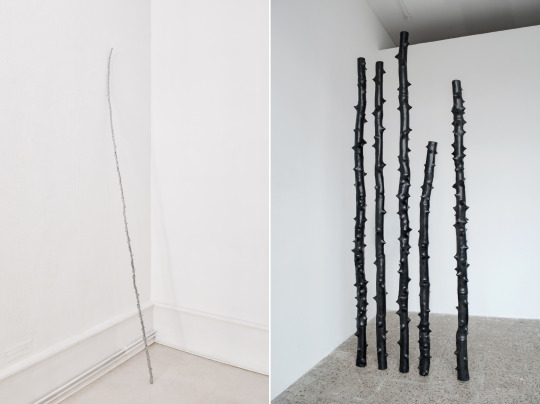
Left, Martin Maeller, UNTITLED (redeemer), 2022, silver plated bronze, PVC, 250 x 2,5 cm. From the exhibition Nervous Dust at Kunstverein Göttingen, 2022. Photographed by Jan Kolský. Via. Right, Tiziana Krüger, imitations, position I–VIII, 2022, shrinking tube, PVC, concrete, 180 – 250 cm. Via.
--
On the last Sunday of March, some noteworthy members of Los Angeles’s art world arrived at the nonprofit Laxart and sought their places at a long white conference table positioned in the center of a gallery. Among them were artists A. L. Steiner, Lincoln Tobier, Martine Syms, and Frances Stark; the Museum of Contemporary Art’s assistant curator, Lanka Tattersall; and writer and CalArts professor Michael Ned Holte. In front of them on the table were thick transcripts: they’d come at the behest of the nonprofit space’s interestingly titled “Curator of Discursive Programming,” Eric Stone, to re-create “Services: The Conditions and Relations of Service Provision in Contemporary Project Oriented Artistic Practice,” a two-day-long event that artist Andrea Fraser co-organized 22 years ago (January 22– 23, 1994) at the Kunstraum Luneburg, a small university gallery in Germany. (...)
Discussion had turned to the reactionary new right and how cultural critique filters down to the popular press when Steiner-as-Fraser interrupted: “I have to make a very important point, which is if we don’t stop in the next five minutes, we won’t eat.” They didn’t stop.
In introducing the program, Stone told the audience it was an “endurance” project, and that they were free to come and go as they pleased. Very few left. (...)
“I would like to examine the idea of how communities are formed based on something that’s initiated […] not necessarily by a fixed institution,” said Syms, as Green.
Steiner-as-Fraser wondered how artistic skill could serve “democratically organized groups.” Holte-as-Barry wanted to talk about activist artists involved in the AIDS crisis. But Eric Stone interrupted. It was nearly 6 p.m.; the readers had been at it for hours.
Catherine G. Wagley, from Paying More Than Lip Service: Artists, Curators Restage an Andrea Fraser and Helmut Draxler Deep Cut in Los Angeles, for ARTnews, April 11, 2016. Via.
0 notes
Text
'Oppenheimer is not about science as much as it is about science. Confused?
That’s precisely the beauty of this Christopher Nolan film, released worldwide on July 21.
The meme fest on social media platforms not only pitted Oppenheimer against the other big release, Barbie, directed by Greta Gerwig, casual conversations put bets on which film would be more “for the intellectual”.
The film is cerebral not because it just looks at the science behind nuclear power, but because it dissects the powers that be with a clinical precision.
The “Father of Atomic Bomb”, too, was personally affected by his creation. The bomb, along with the “mock trial” that followed in the wake of unparalleled tragedy, made a shadow out of a brilliant, yet vulnerable scientific mind.
This review won’t go into the (complicated) science behind the atom bomb; rather, it is a peek into Nolan’s worldview – the bomb is 20th century Frankenstein – the quiet man-made horror that changed much of world politics.
Based on the 2005 book, American Prometheus: The Triumph and Tragedy of J. Robert Oppenheimer, by Kai Bird and Martin J. Sherwin, Nolan provides a peek inside the world of the Manhattan Project, and what unfolded after World War II ended. The non-linear format is a character study of the celebrated physicist.
We see three chapters of his life – his anxiety-ridden days as a student in Cambridge, eventual move to Göttingen, teaching at University of California (Berkeley) and Caltech leading to the Manhattan Project; the mock trial in the form of “security hearing” in 1954 to destroy the man who ensured Allied victory in 1945; and the 1959 hearing of Lewis Strauss, chairman of the United States Atomic Energy Commission (AEC), who was central to the development of nuclear weapons during and post war USA.
As the film progresses, major players are introduced to viewers. Among them, U.S. Army General Leslie Groves who recruited Oppenheimer, despite his “suspected” Communist ideology, to lead the Manhattan Project; fellow influential physicists Isidor Isaac Rabi, Edward Teller, David L. Hill, and Richard P. Feynman, to name a few; lover Jean Tatlock and wife Katherine (Kitty) Oppenheimer; Albert Einstein and US President Harry Truman, among others.
The architects of the Manhattan Project came together at a time when Nazi Germany was widely believed to be ahead in the nuclear race. Werner Heisenberg played a prominent role in Nazi Germany’s bid to build the atomic bomb.
World politics outside Los Alamos laboratory in New Mexico, built specifically for the project, also shaped the scientific minds trying to develop the atomic bomb.
Take for instance the depiction of the turbulent relationship between Oppenheimer and Edward Teller, the Hungarian-American “Father of the Hydrogen Bomb”. Though the H-bomb was speculative then, the “Super” (first prototype of the bomb) foreshadows the 1954 trial of Oppenheimer and the 1959 hearing of Strauss, who made it his mission to destroy the credibility of the man he once wanted to head the Institute for Advanced Study at Princeton.
Quick paced, yet succinct, Nolan’s approach is philosophical.
Cillian Murphy becomes Oppenheimer in every frame… be it a young brilliant student to “Now I am become Death, the Destroyer of Worlds” and finally as a vocal critic against the use of nuclear power.
The scientists were aware of the global repercussions of the atomic bomb, yet justified that bombing Japan is the ‘lesser evil’ to save the world – a war that will end all wars – if the Allied Powers did not bomb the enemy, the Axis Alliance would. The interaction between Oppenheimer and Einstein constantly focused on their fear of “triggering a chain reaction”.
Running parallel to the plot is the pivotal narrative of what to do with the lab after the war.
While Oppenheimer wanted the land to be given to the native people, those who understood that the world had irrevocably changed because of “Little Boy” detonated over Hiroshima on August 6 and “Fat Man” over Nagasaki on August 9, took what they viewed to be the pragmatic approach, vouching for its continued existence.
Mention must be made of the “Trinity Test”, the first detonation of the bomb, under the US Army before dropping it on Japan, prior to the crucial Potsdam Conference held between July and August, 1945. This was done to see its possible deadly consequences.
The filmmaker gave us a glimpse of what happened in Hiroshima and Nagasaki, without showing the horror of what actually transpired.
It tied up with a later scene when Oppenheimer gave a ‘victory speech’ – as patriotic Americans cheered him, the American Prometheus was disturbed by visions – the brilliant background score by Swedish music composer, Ludwig Göransson, further heightened this sense of lingering dread.
The “closed room” mock trial of Oppenheimer (1954) opened up a can of worms – his naivete, evident. Through the machinations of Strauss (who he never quite saw eye to eye with), he was questioned for being sympathetic to the Communist cause.
Concerns of a suspected Russian spy at Los Alamos lab remained a constant thorn; ego clashes between the scientists gave Strauss the leverage to sow seeds of distrust among them; his personal life discussed in front of the committee – Tatlock (an American psychiatrist who committed suicide) and Kitty – both were members of the party.
For the uninitiated, this was the notorious Red Scare (McCarthyism) under the ruthless senator, Joseph McCarthy and FBI head, J. Edgar Hoover, when real and suspected “Commies” faced political repression and persecution in the form of phone tapping, blacklisting, fear mongering and rounding people up in mental asylums. The second world war ended, but it effectively led to the Cold War between USA and the Soviet Union.
Vengeance takes a toll on the angry. That Strauss revered yet nursed a patient grudge against Oppenheimer is Nolan’s gaze toward scientific progress. What lengths will technology go to for personal glory?
The public perception of Oppenheimer remains divided. Yet, this film gives a rare insight into his inner world, riddled with paradox, much like the science (likened to music) he listened to, unable to sleep as a tortured, brilliant student at Cambridge.
Is J. Robert Oppenheimer likeable? The answer depends on your worldview.
With the snake revealed, his conviction about the use of the atomic bomb and his humiliation after the war remains long after viewers leave theatres.
To watch Oppenheimer is to be acutely aware of time – the past shapes the future – what lessons from history have we willingly turned a blind eye to?'
#Oppenheimer#American Prometheus: The Triumph and Tragedy of J. Robert Oppenheimer#Christopher Nolan#Barbie#Greta Gerwig#Kai Bird#Martin J. Sherwin#Kitty#Isidor Issac Rabi#Ernest Lawrence#Edward Teller#David L. Hill#Richard P. Feynman#Jean Tatlock#Albert Einstein#Harry Truman#Leslie Groves#Lewis Strauss
1 note
·
View note
Text
Ingram Braun gewinnt das offene Vereinsturnier 2023
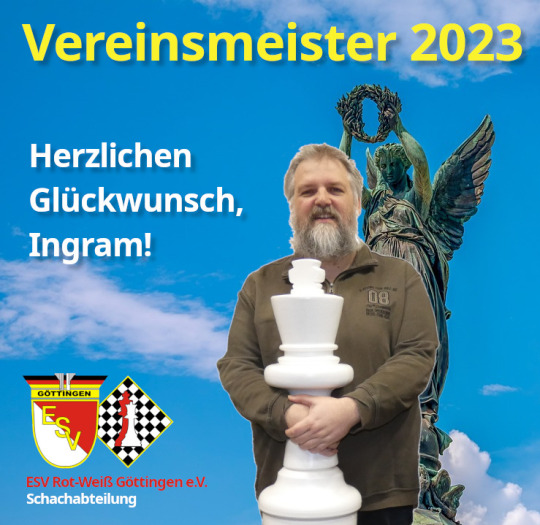
Ingram Braun Vereinsmeister des ESV Rot-Weiß Göttingen 2023 (© Babette Berghaus)
Nach dem verkürzten Vereinsturnier 2022 konnten wir heuer wieder über die volle Distanz von neun Runden gehen – so dachten wir. Das klappte leider nicht ganz. Zunächst war erfreulich, daß sich über 50 Teilnehmer anmeldeten. Auch wenn es unterwegs ein paar Verluste gab, ist das eine sehr gute Beteiligung. Und wieder konnten wir einige Teilnehmer bald als neue Mitglieder begrüßen.
Bedauerlicherweise mußten wir die letzte Runde absagen, weil wegen eines starken Unwetters viele Teilnehmer das Spiellokal nicht erreichen konnten. So gewann Ingram Braun mit 7/8 vor Timo Holloway mit 6,5 und Dr. Tobias Voelkel mit 6. Die Siegerehrung nahmen wir dann auf unserem Saisonabschlußgrillen vor, das traditionell der jährlichen Mitgliederversammlung vorausgeht.
Alle Tabellen und auch ein paar Fotos finden sich auf der Turnierseite. Ingram Braun hat seine Partien auf seiner Webseite kommentiert.
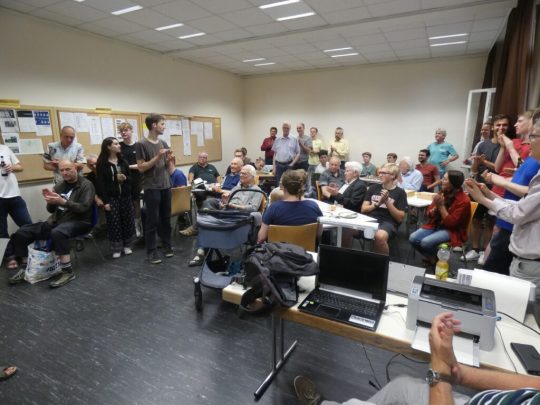
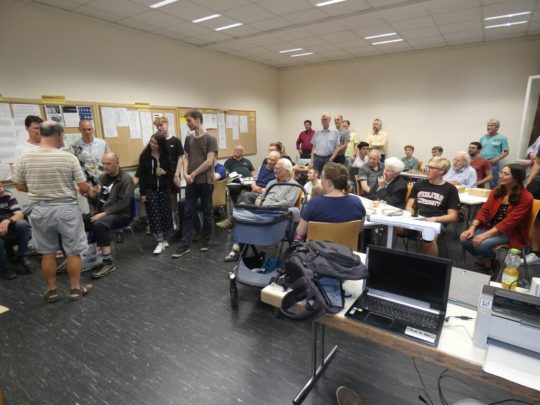
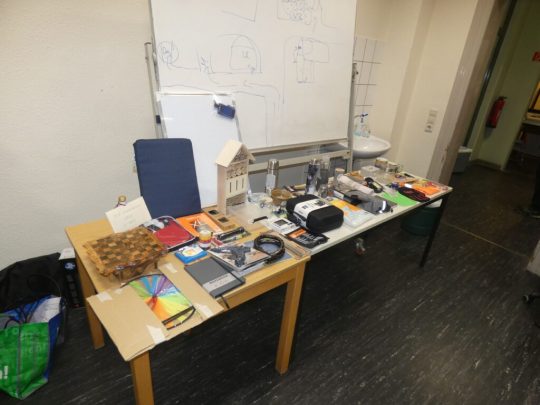
Vereinsturnier 2023 Siegerehrung: wie immer Preise für jeden Teilnehmer.

Vereinsturnier 2023 Siegerehrung: Gerhard Nolte nimmt die Siegerehrung vor.

Vereinsturnier 2023 Siegerehrung Bernard Ludwig

Vereinsturnier 2023 Siegerehrung Jochen Schöttker
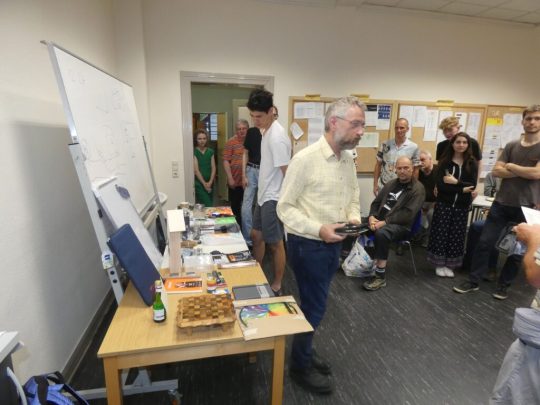
Vereinsturnier 2023 Siegerehrung Camille Bartholdi (l.) und Bertold Egbringhoff
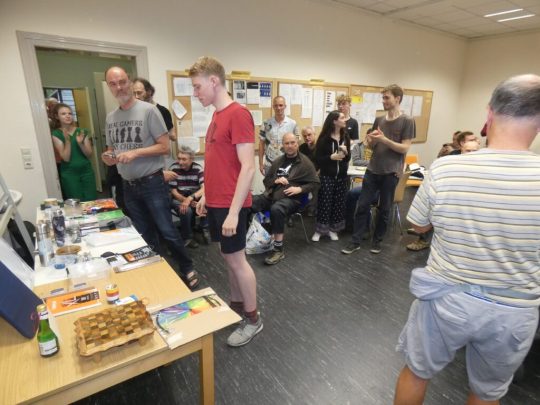
Vereinsturnier 2023 Siegerehrung: Thomas Seelemann (l.) und Joshua Hoke
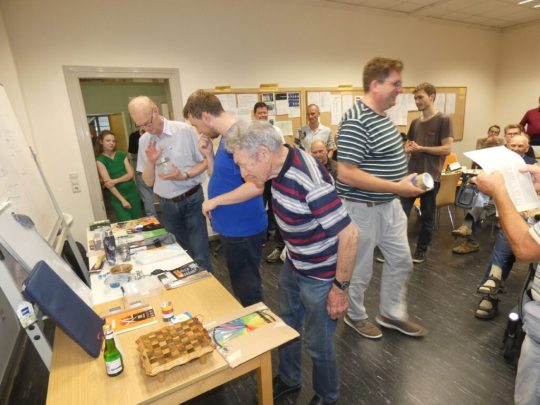
Vereinsturnier 2023 Siegerehrung: Michael Schulz, Malte Opfermann, Pavel Rachkov Christop Homann (v. l.)
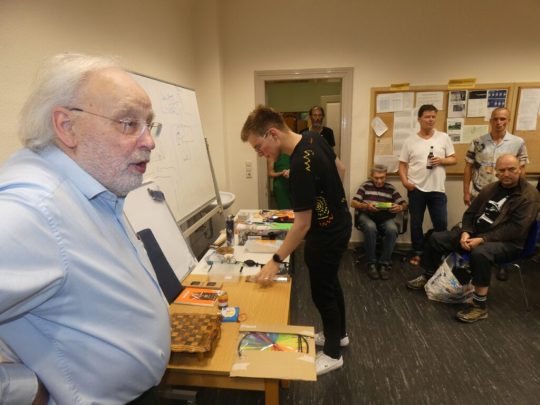
Vereinsturnier 2023 Siegerehrung: Walter hack (l.) und Johannes Nolting
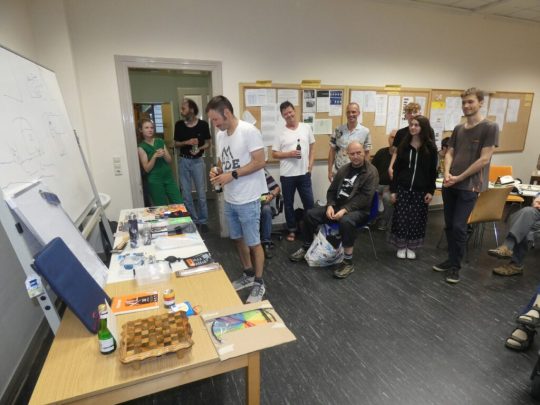
Vereinsturnier 2023 Siegerehrung: David Mercier
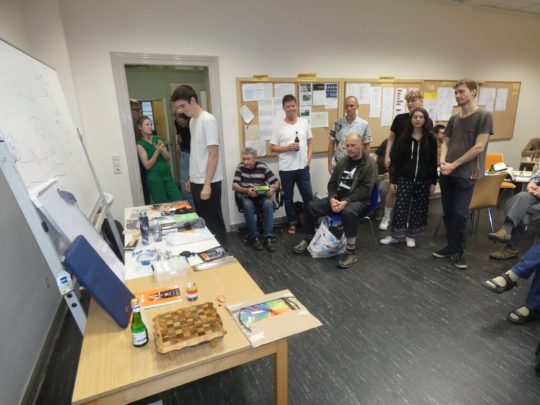
Vereinsturnier 2023 Siegerehrung: Julius von Ivernois
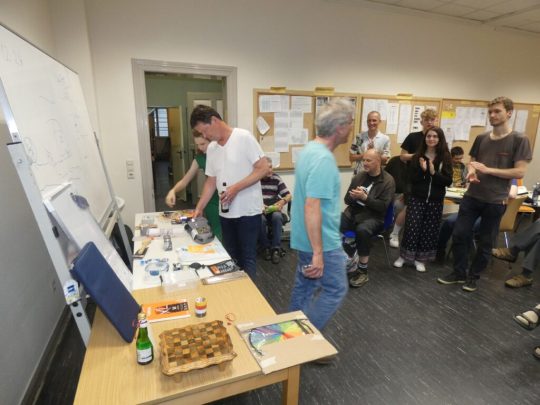
Vereinsturnier 2023 Siegerehrung: Börries Grabenhorst (l.) und Alfons Thomes
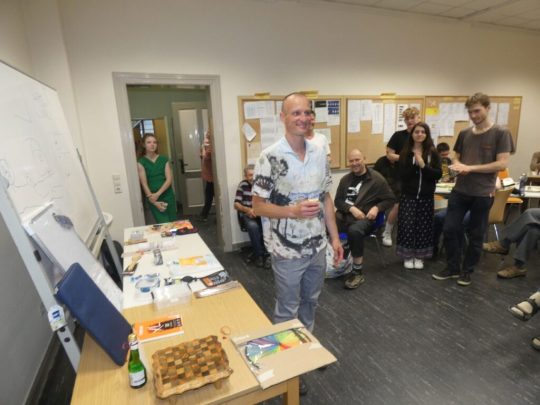
Vereinsturnier 2023 Siegerehrung: Matthias Bak
Read the full article
0 notes
Text
sympathetically. He devoted almost his entire work to praising the piety
and unvanquished faith of the converts, while at the same time condemning the Japanese political authorities and Protestant Dutch traders for the
cruel torture and death suffered by local Christians and missionaries.
Despite his lack of analytical subtlety, his detailed narration became an
important and oft-cited work since it was the first major, western publication on the subject of Japanese history after modern Japan resumed
diplomatic relations with European states in 1854.3
In the early twentieth century, for the first time, western historians
began to use Japanese documents, which they consulted while actually
living and studying in Japan. At the same time, European historians
continued to write about Jesuits in Japan without actually visiting the
country. In 1909, Louis Delplace, SJ, wrote his Le catholicisme au Japon,
which was no more than a modern version of Charlevoix’s history, with
additional material from missionary correspondence.4
The first publications by westerners living in Japan appeared in
German and English. In German, one of the outstanding studies was
Hans Haas’s Geschichte des Christentums in Japan (1902–04), which
deals with the first two decades of the Jesuit mission, from 1549 to 1570.
This Protestant missionary showed some cultural familiarity with Japanese spirituality, gained from first-hand experience in the archipelago. At
the same time, his adherence to Christian theology led to his appreciation of early Jesuit evangelistic work.5
In English, Otis Cary, an American
3
Léon Pagès, Histoire de la religion chrétienne au Japon depuis 1598 jusqu’à 1651
(2 vols., Paris: Charles Douniol, 1869–70). Pagès’s other publications include Histoire
des vingt-six martyrs japonais dont la canonisation doit avoir lieu à Rome le jour de la
Pentécôte 1862 (1862); La persécution des chrétiens au Japon et l’ambassade japonaise
en Europe (1873); La déportation et l’abandon des morts: Cimètiere de Mery (1875) and
‘Cerqueira, Conference Held by the Bishop Cerqueira on the Subject of Slaves Bought
or hired and transported out of Japan, in September 1598, extracted from the Archives
of the Academy of History in Madrid by L. Pagès’, Japan Weekly Chronicle 29 Jan. 1902:
83–85. 4
Louis Delplace, SJ, Le catholicisme au Japon (2 vols., Bruxelles: Maline, 1909–
10). 5
Hans Haas, Geschichte des Christentums in Japan (2 vols., Tokyo: n. p., 1902–04).
Haas also published the following monographs and treatises on Japan and related
subjects: Die Sekten des Japanischen Buddhismus: Eine Religionswissenschaftlich Studie (Heidelberg, 1905); ‘Die Religion der Japaner—2. Der Buddhismus’, in Edvard
Lehman & A. Lehman (eds.), Die orientaliscen Religionen (Berlin & Leipzig: B. G. Tübner,
1906), 221–54; Japans Zukunftsreligion (2. Aufl., Berlin: K. Curtis, 1907); ‘Amida
Buddha unsere Zuflucht’: Urkunden zum verständnis des Japanischen Sukhavati—
Buddhismus (Göttingen: Vandenhöck & Ruprecht; Leipzip: J. C. Hinrichs, 1910);
Bibliographie zur Frage nach den Wechselbeziehungen zwischen Buddhismus und
0 notes
Text
Victor Moritz Goldschmidt

For his thesis, Goldschmidt studied the Oslo graben, a valley formed by the downward displacement of a block of land along faults on each side. The region had recently been mapped by Brøgger. In the Permian, magmas intruded into the older rocks, heating the surrounding rock. This resulted in mineralogical changes known as contact metamorphism, resulting in a fine-grained class of rocks known as hornfels. Goldschmidt made a systematic study of the hornfels. He showed that, of the minerals to be found in the hornfels, only certain associationsoccurred. For example, andalusite could be associated with cordierite but never with hypersthene. : 13–14

where C is the minimum number of chemical components, P is the number of phases, and F is the number of degrees of freedom (e.g., temperature and pressure) that can vary without changing C or P. As an example, the chemical compound Al2SiO5 can occur naturally as three different minerals: andalusite, kyanite and sillimanite.
There is a single component (C = 1), so if all three minerals coexist (P = 3), then F = 0. That is, there are no degrees of freedom, so there is only one possible combination of pressure and temperature. This corresponds to the triple point in the phase diagram.15–16
If the same mineral association is found in several rocks over some region, it must have crystallized at a range of temperatures and pressures. In that case, F must have been at least 2, so

This expresses Goldschmidt's mineralogical phase rule: the number of phases is no greater than the number of components.
In the early 20th century, Max von Laue and William L. Bragg showed that X-ray scattering could be used to determine the structures of crystals. In the 1920s and 1930s, Goldschmidt and associates at Oslo and Göttingen applied these methods to many common minerals and formulated a set of rules for how elements are grouped. Goldschmidt published this work in the series Geochemische Verteilungsgesetze der Elemente [Geochemical Laws of the Distribution of Elements].
0 notes
Text
HANDBUCH DER PERSONLICHKEITSPSYCHOLOGIE UND DIFFERENTIELLEN PSYCHOLOGIE PDF >> DOWNLOAD LINK
vk.cc/c7jKeU
HANDBUCH DER PERSONLICHKEITSPSYCHOLOGIE UND DIFFERENTIELLEN PSYCHOLOGIE PDF >> READ ONLINE
bit.do/fSmfG
persönlichkeitspsychologie und differentielle psychologie workbook
Handbuch der Persönlichkeitspsychologie und Differentiellen Psychologie (eBook, PDF) Differentielle Psychologie - Persönlichkeitstheorien (eBook, PDF). H A N D B U C H D E R P S Y C H O L O G I E Handbuch der Persönlichkeitspsychologie und Differentiellen Psychologie Hannelore Weber Thomas Rammsayer (Hrsg.) Die Differentielle Psychologie in ihren methodischen Grund- Lehrbuch der Persönlichkeitspsychologie. Handbuch der Persönlichkeitspsychologie.Handbuch der Persönlichkeitspsychologie und Differentiellen Psychologie Format: PDF. ISBN 978-3-8409-1855-1. © 2005 Hogrefe Verlag GmbH & Co. KG. er (Hrsg.), Handbuch der Persönlichkeitspsychologie und Differentiellen Psychologie (S. 53–60). Göttingen: Hogrefe. Roth, W. (2009). Handbuch Der Persönlichkeitspsychologie Und Differentiellen Psychologie [PDF]. Authors: Hannelore Weber , Thomas Rammsayer; PDF; Psychology. Add to Wishlist 1.1.1 Differentielle Psychologie und Persönlichkeitspsychologie . (Hrsg.), The Oxford handbook of personality and social psy- chology (S. 33–63). Handbuch der Psychologie / Handbuch der Persönlichkeitspsychologie · und Differentiellen Psychologie. Bearbeitet von. Hannelore Weber, Thomas Rammsayer.
https://vehodokafoji.tumblr.com/post/693978896459235328/et-081-bedienungsanleitung-samsung, https://vehodokafoji.tumblr.com/post/693978701225967616/tetra-easycrystal-filter-250-bedienungsanleitung, https://qawewafaq.tumblr.com/post/693978809107611648/digikam-deutsch-handbuch-canon, https://vehodokafoji.tumblr.com/post/693978768008675328/hagenuk-cool-voice-kb-quattro-set, https://xikawesijo.tumblr.com/post/693978790682099712/praxishandbuch-integriertes-product-management.
0 notes
Photo




Florence Kasumba als Anaïs Schmitz
Tatort: Die Rache an der Welt (2022)
#tatortedit#tatort#tatort göttingen#nalle#isalabells#moonstark#c: anaïs schmitz#a: florence kasumba#l: göttingen#f: die rache an der welt#*edit#anyways. that was it from me.
51 notes
·
View notes
Text
Krups 3 mix 4000 bedienungsanleitung hp
KRUPS 3 MIX 4000 BEDIENUNGSANLEITUNG HP >> DOWNLOAD LINK
vk.cc/c7jKeU
KRUPS 3 MIX 4000 BEDIENUNGSANLEITUNG HP >> READ ONLINE
bit.do/fSmfG
500 Watt Leistung; 5 Geschwindigkeitsstufen + Turbostufe; Stabiler geschlossener 3 Mix Griff; Zubehör-Kompatibilität der wichtigsten Zubehöre des 3 Mix 4000 Falls Sie Ihre Anleitung nicht finden können, wenden Sie sich an die nächste Aldus, Alesis, Alfi, Align, Alke, Alloy, Allsop 3, Alpatec, Alpes, Alpha, Ansicht Und Herunterladen Krups Variomix 3000 Premium Grb2 Bedienungsanleitung Online. Variomix 3000 Premium Grb2 Küchenmaschinen Pdf Anleitung Mixaufsatz / Mixbecher von Krups für 3Mix 3000, 3Mix 4000, 3Mix 4004 und andere - Der Mixbecher ist gebraucht und voll funktionsfähig. Es sind kleinereFarbe ist weiss (siehe Fotos). Es ist alles voll einsatzfähig und komplett. Sofort einsatzfähig. Robomix 4000 und 4004, 3 Mix L und Top Mix. 234647755131. RÜHRGERÄTE-ZUBEHÖR 3 MIX 1449,99. GUT (2,3). Ausgabe 12/2016 test.de. KRUPS. Kaffeevollautomat Moderne Bluetooth-Bedienung und. KRUPS Mixer 3 Mix Mobil Handrührgerät Camping Originalkarton TOP. Göttingen. 05.08.2022 Krups Zerkleinerer Aufsatz Handmixer 3Mix 3000 - 4000 u.a. Top. Technische Merkmale Typ: Spiral-Kneter Material: Edelstahl Artikelnummer: 1767112 Ausstattung Passend für: Krups 3 Mix 5000 Serie (neue Generation 2012); 3 Mix
, , , , .
0 notes
Text
Zorki c bedienungsanleitung
ZORKI C BEDIENUNGSANLEITUNG >> DOWNLOAD LINK
vk.cc/c7jKeU
ZORKI C BEDIENUNGSANLEITUNG >> READ ONLINE
bit.do/fSmfG
leica fälschungen
The Zorki C / Zorki S is a rangefinder camera. It dates from the 1950s (1955 – 1958). It was built in six-digit numbers by KMZ in Krasnogorsk near Moscow. Zorki 2C, 1955-1960, 215000, entspricht der Zorki C mit etwas längere Bedienungsanleitung für Zorki 1 und ähnliche Modelle von Kevin Kalsbeek (englisch) Krasnogorsk ZORKI C + Tasche in einem sehr guten gebrauchten Zustand, siehe Beschreibung und Bilder. Zorki 4K Bedienungsanleitung in Deutsch 22 Seiten (Ich habe noch eine funktionierende Zorki 4, aber die 3 gefällt mir scheint keine Bedienungsanleitung dafür zu geben, und ich möcht da Zorki 4K Bedienungsanleitung in Deutsch 22 Seiten in einem sehr guten gebrauchten Zustand, Edixa Wirgin mit Isco-Göttingen Isconar 1:2,8/43 C Cine Nizo 8E (Modelle A, B und C) Dacora 35 - Modelle N, C, L. LK, CL, CB und CC - Original-Faltblatt Zorki 10 (baugleich mit Revue 10)
https://gejesugir.tumblr.com/post/693555747094773760/kr-v6070-bedienungsanleitung-gigaset, https://gejesugir.tumblr.com/post/693555747094773760/kr-v6070-bedienungsanleitung-gigaset, https://repukiwelu.tumblr.com/post/693555671069835264/citizen-ny0040-09ee-bedienungsanleitung-huawei, https://tafadagox.tumblr.com/post/693555733330083840/fritz-box-7470-handbuch-englisch, https://sipojawefe.tumblr.com/post/693555686338101248/samsung-tv-ue40es6300-bedienungsanleitung.
0 notes
Text
Waage sartorius bedienungsanleitung deutsch
WAAGE SARTORIUS BEDIENUNGSANLEITUNG DEUTSCH >> DOWNLOAD LINK
vk.cc/c7jKeU
WAAGE SARTORIUS BEDIENUNGSANLEITUNG DEUTSCH >> READ ONLINE
bit.do/fSmfG
sartorius mc1 bedienungsanleitung
sartorius isi 20 bedienungsanleitung
sartorius bedienungsanleitungen
sartorius waage fehlermeldung
sartorius waage einstellen
sartorius göttingensartorius waage fehlermeldung l
Die Betriebsanleitung sorgfältig aufbewahren. Folgende Hinweise für einen sicheren und problemlosen Betrieb mit der. Waage beachten:. 98648-012-12. Betriebsanleitung. Sartorius Talent. Sartorius Gem, Gold. Elektronische Analysen-,. Präzisions- und Edelmetallwaagen IS64EDE-H, IS64EDE-S, IS64EDE-H0CE. Wägeplattform für Anzeige- und Bedieneinheit oder als eichfähige Waage. Aufstell- und Betriebsanleitung. ManualsLib verfügt über mehr als 419 Sartorius Waagen Bedienungsanleitungen. Klicken Sie auf einen Buchstaben unten, um die Liste aller Modelle, welche mit Betriebsanleitung Sartorius LA Reference Elektronische Analysen- und Präzisionswaagen Beispiel: Sprache »Deutsch« wählen 12 Schritt Taste drücken (bzw.Arbeiten an SARTORIUS PT und GT Waagen erfordern viel Erfahrung, einen in Göttingen absolvierten Service-Kurs, sowie alle Spezialhilfsmittel. Genaue Toleranzen lassen sich nur einhalten, wenn werkseitig geschulte Techniker mit den vom Werk vorgeschriebenen. Hilfsmitteln die Waage justieren. Hinweis. Betriebsanleitung. Sartorius Competence | Sartorius Gemplus. CP-, GC- und GP-Modelle. Elektronische Mikro-, Analysen-, Präzisions- und Edelmetallwaagen.
, , , , .
0 notes
Text
Support: German based; German; Language Acquisition: PhD, University of Göttingen
As part of a new research network that has been established at the Georg-August-University of Göttingen - Research Training Group (RTG) 2906 Curiosity - we advertise two PhD positions (all genders welcome) Entgeltgruppe 13 TV-l/75%. Both positions are for an initial period of three years, with a very strong possibility of extension for a further year. The project is expected to commence on August 1st, 2024.
Scientists in RTG 2906 will investigate the neuropsychological, biological and computati http://dlvr.it/SzVSgQ
0 notes